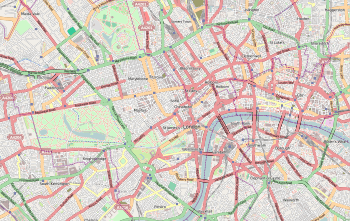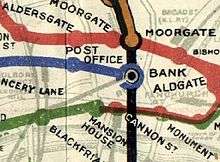St. Paul's tube station
| St. Paul's | |
|---|---|
|
Western entrance to St. Paul's (2009) | |
 St. Paul's Location of St. Paul's in Central London | |
| Location | St Paul's |
| Local authority | City of London |
| Managed by | London Underground |
| Number of platforms | 2 |
| Fare zone | 1 |
| London Underground annual entry and exit | |
| 2012 |
|
| 2013 |
|
| 2014 |
|
| 2015 |
|
| Railway companies | |
| Original company | Central London Railway |
| Key dates | |
| 30 July 1900 | Opened as Post Office |
| 1 February 1937 | Renamed St. Paul's |
| Other information | |
| Lists of stations | |
| WGS84 | 51°30′53″N 0°05′51″W / 51.5148°N 0.0975°WCoordinates: 51°30′53″N 0°05′51″W / 51.5148°N 0.0975°W |
|
| |
St. Paul's is a London Underground station located in the City of London financial district. The station, which takes its name from the nearby St Paul's Cathedral, is on the Central line, between Bank and Chancery Lane stations, and is in fare zone 1.
It should not be confused with City Thameslink railway station which opened in 1990 with the name St. Paul's Thameslink, but is some distance from the Underground station. That station was subsequently renamed City Thameslink to avoid confusion for the emergency services, but for some years afterwards many maps and guidebooks in circulation continued to carry the earlier name.
History
The station was opened by the Central London Railway (CLR) on 30 July 1900 with the name Post Office, after the headquarters of the General Post Office on nearby St Martin's Le Grand. The name Post Office was possibly chosen instead of the more obvious St. Paul's to differentiate it from a South Eastern Railway (SER) station which already held that name (but which today is called Blackfriars).

The station entrance was originally located on the north side of Newgate Street, on the west side of the junction with King Edward Street, but was moved to the east when the station was modernised in the 1930s with an underground ticket hall and escalators. A modern ventilation shaft in the centre of the traffic island at the junction indicates the location of the original lift shafts. When the SER station called St. Paul's was renamed as Blackfriars in 1937, the Underground station called Post Office took the name St. Paul's, which it has kept ever since.
At the end of the 19th century, Newgate Street was a narrow road with some of its mediaeval character remaining. To reduce land purchase and compensation payments, the CLR routed its tunnels directly under public roads. At St. Paul's the narrowness of the road required the tunnels to be placed one above the other with the westbound tunnel uppermost. The lifts originally operated to a level between the two platforms, with stairs up or down to the platforms as necessary. A high-level access passageway is visible at the lowest level leading to the disused lift lobby.
During the Second World War the electricity grid control room for London and Southeast England was housed below ground in the lift shaft.
The station today

The station entrances are located around the junction of Newgate Street, Cheapside and St Martin's Le Grand. St Paul's Cathedral is a short distance to the south. Visitors should note that the main entrance to the cathedral is at its western end, a few minutes' walk away.
St. Paul's is also the nearest Underground station to the London Stock Exchange and One New Change. Other notable sites in the vicinity include the Old Bailey, Museum of London and the church of St Mary-le-Bow.
Connections
London Buses routes 4, 8, 25, 56, 100, 172, 242, 521 and night route N8 serve the station.
Gallery
- Western entrance with St Paul's Cathedral in the background (2003)
- The westbound platform (2009)
- Platform roundel (2008)
Notes
- 1 2 3 4 "Multi-year station entry-and-exit figures" (XLS). London Underground station passenger usage data. Transport for London. April 2016. Retrieved 3 May 2016.
External links
| Wikimedia Commons has media related to St Paul's tube station. |
- Abandoned stations - Section on disused lift access passage
- London Transport Museum Photographic Archive
| Preceding station | Following station | |||
|---|---|---|---|---|
| Central line |